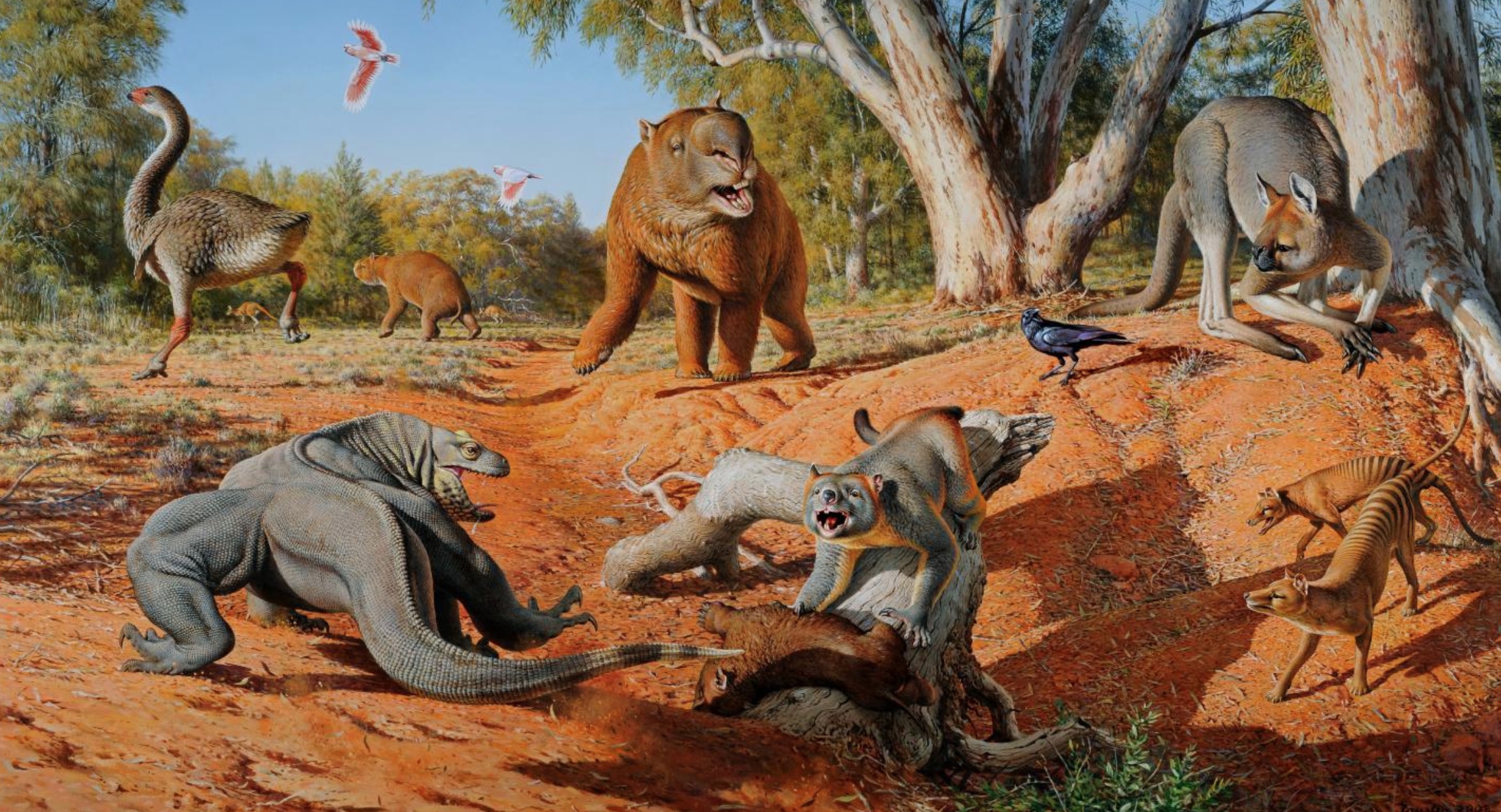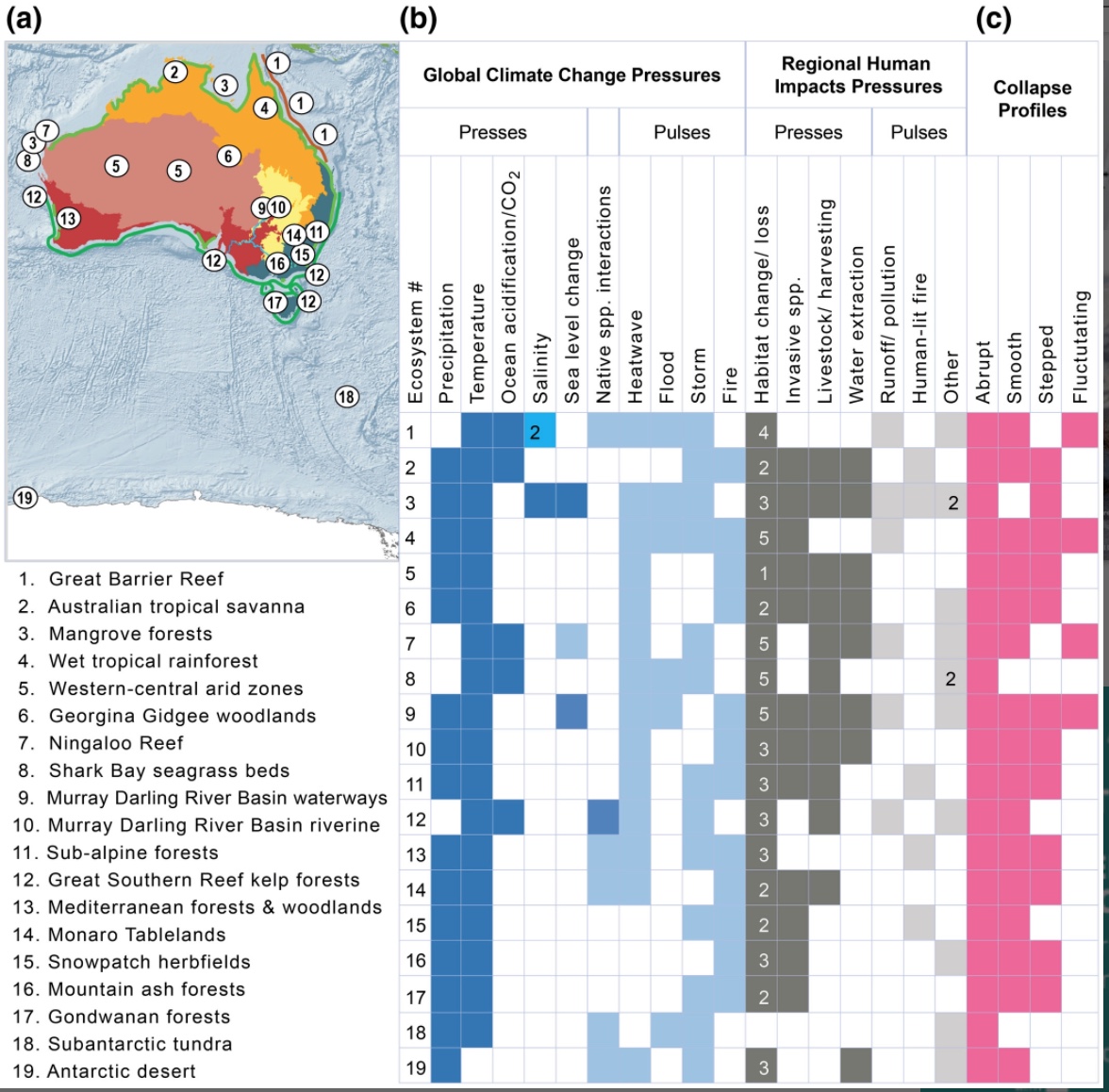The general uncomfortable relationship between the anthropogenic effects of human civilization and biodiversity is well known. A synopsis of major events in that relationship that have unfolded in North America might include:
- 9,000 BCE - Pleistocene Megafaunal Extinction in which many of the largest land mammals and the predators that depended upon them became extinct at roughly the same time. (The victims were typically creatures with longer gestation periods. Thus, North American horses, camels, and elephants (right) were snuffed, but bison survived.) In the New World this roughly coincides with two major environmental changes:
- The appearance of humans with big game hunting technologies
- The most rapid interval of deglaciation of the Pleistocene.
A loud and emotional debate rages over which of these factors was primarily responsible for the extinction:
- Protagonists like Ernest Lundelius of the University of Texas argue that climate change at the end of the Pleistocene was fundamentally different from previous deglaciations.
- Others, including Paul Martin of the University of Arizona argued for human overhunting of naive wildlife - the Pleistocene overkill hypothesis.
The jury remains hung, however similar stories unfolding on other continents tended to coincide with the arrival of humans:
- Australia ~ 46,000 years ago: Many native mammals, reptiles, birds
- New Zealand ~ 1,000 years ago: Several species of moa - giant flightless birds - and other birds.
- Madagsacar ~ 1,000 years ago: Numerous native mammals and the flightless elephant bird
In all cases the extinctions follow a sequence: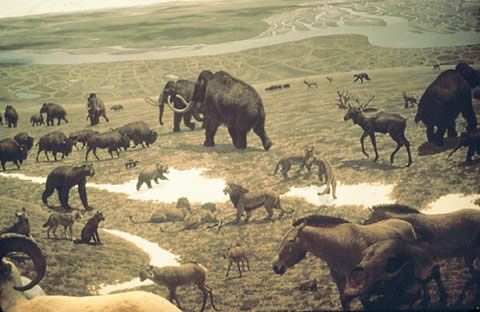
Pleistocene Alaska - mammoth steppe- We start with the removal of large herbivores
- followed by the extinction of the predators that ate them
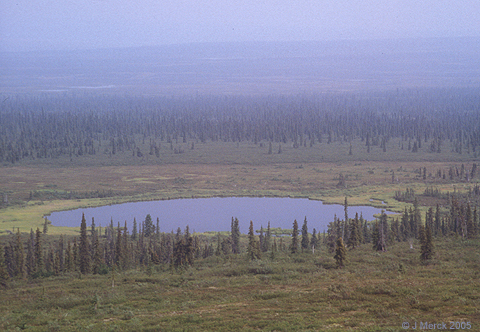
Holocene Alaska - boggy black spruce taiga - often accompanied by changes in flora as the rosters of animals who graze them and fertilize them changes. E.G.: The mammoth steppe of central Alaska gave way to the contemporary scrubby taiga forest or tundra.
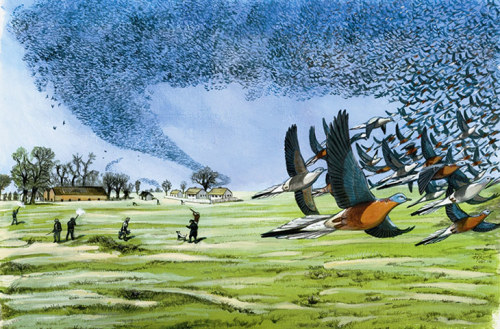
Hunting passenger pigeons in the 19th century - 1492 + - The Columbian Exchange in which entire suites of exotic plants and animals were exchanged between the New and Old Worlds, seriously disrupting ecosystems. The effects could be subtle. For example, immense flocks of passenger pigeons (right) witnessed during the nineteenth century apparently didn't occur prior to 1492 (judging from archeological remains of Indian kitchen refuse.) Evidently some change wrought by the Columbian Exchange released them from their historic ecological limits.

Australian hunter with thylacine trophy - 17th through 19th centuries - Large-scale hunting and extinctions as Europeans colonized the world, introducing more potent methods of hunting and converting large regions to agriculture. E.G. the:
- Dodo (1662) - Flightless pigeon of Mauritius: killed to provision ships, interaction with introduced species, habitat destruction
- Steller's sea cow (1768) - Kelp-eating sea cow of the northern Pacific: hunted to provision ships, blubber used in whale oil trade.
- Great Auk (1844) - killed to provision ships.
- Labrador duck (late 19th century) - Reduction of food supply through encroachment of civilization.
- Passenger pigeon - (1914) killed to satisfy demand for game and feathers (for use in millinary)
- Carolina parakeet (1918) - exterminated as agricultural pest.
- Thylacine AKA "marsupial wolf" (1930) (right) - exterminated as agricultural pest.
- Heath hen (1932) - combination of hunting, habitat destruction, interaction with introduced species, and bad luck.
- Eskimo curlew (1983) - killed to satisfy demand for game and feathers (for use in millinary), suffered from conversion of native grasslands to agriculture, extinction of Rocky Mountain Grasshopper - major food source.

- Well-intentioned folly: Deliberate introductions of exotic species, including
- Eurasian starlings to Central Park, NY
- Mongooses to Hawaii
- Cane toads to Queensland, Australia. (BONUS! Check out the Cane Toad Song from the film Cane Toads.)
The Great Acceleration
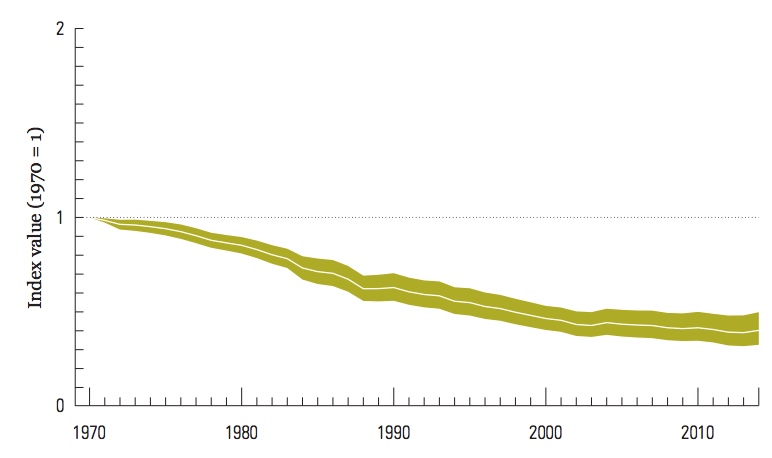
The WWF Living Planet Index, 1970 - 2014
- Wildlife populations have fallen 60% in forty years.
- 75% of plants and land vertebrates that have been extinguished since 1500 suffered effects of:
- Overexploitation
- Conflict with spread of agriculture
- Over last half century, humans' "ecological footprint" (consumption of natural resources) has increased 190%.
- Climate change now exacerbates
- In 2018, ~ one quarter of of Earth land area is free of human impact. By 2050, expected to be one tenth.
- In modern era, we have lost 87% of wetlands - out seriously affected biome.
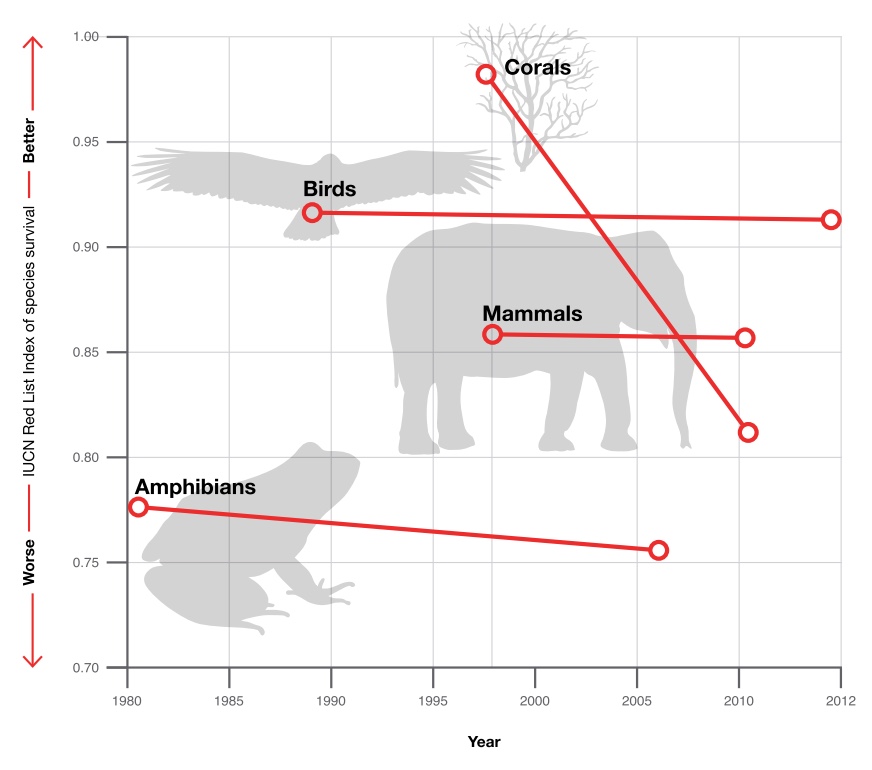
IUCN assessment of extinction rates.
- Overhunting: The collapse of the Atlantic cod and Pacific jack mackerel (right) stem from overfishing using sophisticated methods that give the fish little chance.
- Lack of regulation: Because much ocean fishing occurs in international waters there is no authority to tell commercial fisher to stop. Indeed, in the case of jack mackerel, recognition that the fishery is collapsing seems to have sparked a race among fishing firms to mop up the last remaining profit in the resource. Thankfully, much Atlantic cod is fished in Canadian waters and by Canadian fishermen, enabling the government of Canada to step in to protect the fish.
- Lack of data: Because ocean fish live in an inaccessible environment, we often don't know their status. The Pacific barred sand bass and kelp bass, for example, have recently been shown to have experienced severe reductions. Unfortunately both are primarily fished by amateurs when they congregate to spawn. These intense congregations create the illusion of abundance. Because our knowledge of their abundance was based on the number caught and the fact that fishermen could catch only a small fraction, their actual population decrease was masked.
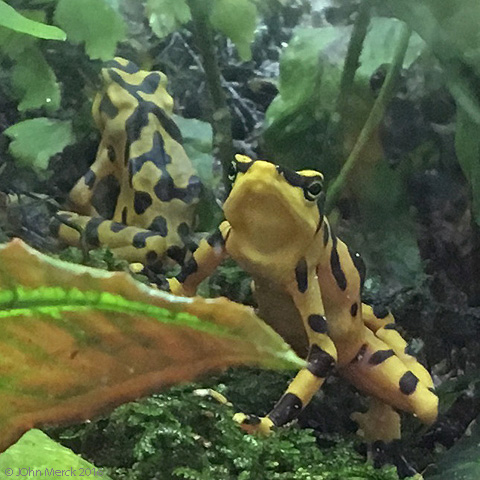
Critically endangered Panamanian golden toad - Atelopus zeteki
- chemical contamination
- over-harvesting
- climate change
- infectious disease, notably the fungal infection Chytridiomycosis
- habitat loss and degradation
- interactions with invasive species
The foregoing refers to the fates of individual species. What about ecosystems - the interlocking, interdependent networks of species and physical environment? Bergstrom et al., 2021. summarized the threat of ecosystem collapse:
"a change from a baseline state beyond the point where an ecosystem has lost key defining features and functions, and is characterised by declining spatial extent, increased environmental degradation, decreases in, or loss of, key species, disruption of biotic processes, and ultimately loss of ecosystem services and functions."
They divide factors degrading ecosystems into:
- Presses: Chronic pressures like temperature or sea-level change
- Pulses: Abrupt pressures like wildfire and runoff-pollution.
Making this especially scary is the fact that ecosystem collapses can adopt different profiles:
- Smooth: Gradual and continuous
- Abrupt: Precipitous collapse when a key threshold is reached
- Stepped: A series of smaller thresholds and abrupt collapses
- Fluctuating: Rapid oscillation between ecosystem states.
- Although ecologists track changes in ecological parameters and attempt to anticipate collapse by extrapolating from trends, they can't anticipate the subtle interactions leading to abrupt collapse.
- Protected habitats designated as national parks and UNESCO World Heritage Sites are equally vulnerable to presses and pulses that are global in nature.
In that connection......
The climate change connection The last four items on this list are arguably connected. Now let's consider the effects of global change on the biosphere. Remember, the physical processes in which climate change is manifested, involve basic requirements of organisms. These include changing:
- gas concentrations
- distributions of heat
- distributions of rainfall
The oceans: The most basic fact of global climate change is the accumulation of CO2 in the atmosphere. CO2 is notoriously water soluble, so the atmospheric CO2 concentration increase is followed by an increase in dissolved CO2 in the shallow oceans. Remember, deep and shallow ocean water don't mix much, so the CO2 is not making it into the deep oceans in quantity. Alas, most marine biomass inhabits this shallow sunlit layer. What are the consequences?
Carbonate chemistry:
Equilibrium constants monitor the extent of chemical reactions at set temperatures and pressures. An equilibrium constant is equal to the concentration of products over reactants.
For a reaction A+B -> C + D (reactants -> products)
K1 = [C][D]/[A][B]
So now consider the carbonate system of equilibrium reaction and constants:

Looking at this reaction series, you would think that adding more CO2 would drive the reactions toward the right and increase CaCO3 precipitation, but this is not the case:
Because they proceed in the same environment, reactants can "leak" from one reaction to the other. K1 is much greater for reaction 2 than reaction 3. Thus, H+ from 2 is able to leak into reaction 3, driving it to the left. paradoxically, precipitation of CaCO3 is facilitated by the reduction of CO2.
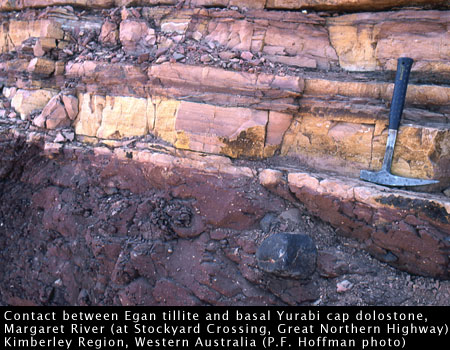 But where, you ask, does the carbon for the CaCO3 come from? Remember that bicarb ion (HCO3-) is a product of continental weathering reactions. In fact, at times when much bare bedrock is exposed (like immediately after glaciations), we see copious cap carbonates (right) superposed over marine glacial sediments, recording accelerating bicarb-producing weathering reactions.
But where, you ask, does the carbon for the CaCO3 come from? Remember that bicarb ion (HCO3-) is a product of continental weathering reactions. In fact, at times when much bare bedrock is exposed (like immediately after glaciations), we see copious cap carbonates (right) superposed over marine glacial sediments, recording accelerating bicarb-producing weathering reactions.
Factors controling carbonate formation:

Bahama Banks from orbit
- temperature (higher -> less CO2 -> more carbonates in warm water.)
- pressure (lower -> less CO2 -> more carbonates in shallow water.)
- degree of agitation (higher -> less CO2 -> more carbonates in well aerated water.)
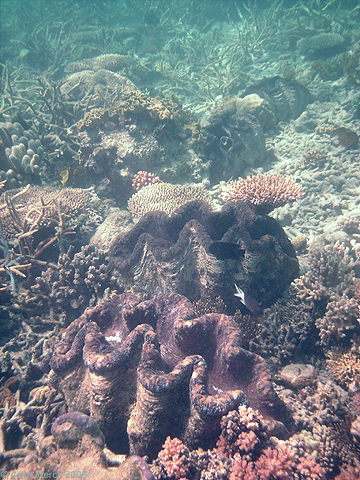 Oceanic acidification: The increase in oceanic CO2 concentration sets off a chain of consequences. The two big ones:
Oceanic acidification: The increase in oceanic CO2 concentration sets off a chain of consequences. The two big ones:
- CO2 interacts chemically with water to make carbonic acid (H2CO3). Thus, the more carbonated the water, the more acidic (i.e. the lower the pH.)
- The presence of more H+ ions in the water moves the carbonate reaction series toward the left. That is, the more acidic the water, the more difficult it is for calcium carbonate to precipitate as a solid, either inside or outside of a living body.
- Most marine critters with hard skeletons make them out of calcium carbonate. The includes:
- mollusks like snails and clams (right)
- echinoderms
- bryozoans
- a host of microscopic organisms
- corals, the worlds dominant reef formers.
Note: Reefs are not inevitable. There have been intervals of Earth history that were essentially reefless, including the Triassic and Early Jurassic. (Both intervals followed mass-extinctions in which high levels of CO2 have been implicated as causitive agents.) It would be naive to think that reef organisms can just bounce back from a global calamity.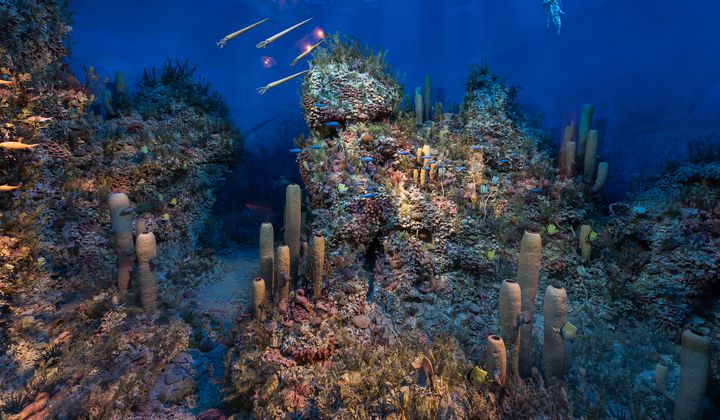
Before - Permian sponge reef
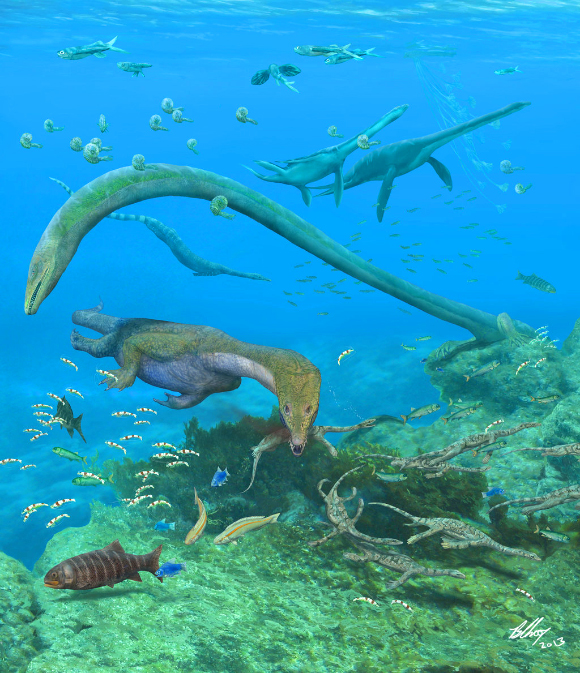
After - Triassic ocean - critters but no reefReef erosion is already documented in some locations. There is concern that by 2050, net reef erosion may exceed reef deposition.
- Reefs are a particularly biologically productive community, analogous to forests. The presence of reef-building organisms makes a complex community of other organisms possible. Reef reduction will result in:
- Reduction in reef community biomass
- Significant changes in ocean-floor topography
- High CO2 concentrations directly effect organisms in other ways. Acidosis (buildup of carbonic acid in tissues) can result in a range of pathologies from reduced immune response to asphyxiation. Note: many sea creatures don't actively regulate CO2 concentrations in their bodies and are particularly vulnerable.
- The microscopic carbonate-shelled algae at the base of the marine food chain are among the most vulnerable to acidification. Their reduction threatens oceanic food chains.
Observations to date include:
- Drop in mean oceanic pH from 8.2 to about 7.7.
- Significant reductions in biogeochemically important bacteria including sulfur compound metabolizing Roseobacter.
- Increase in frequency of coral bleaching events, in which high temperatures disrupt corals' relationship with algal symbionts.
- Laboratory exposure of carbonate secreting organisms like pteropods (pelagic snails) to projected pH of 2100 results in 30% reduction in rate of shell growth.
- Generally, sea-floor biomass seems to be decreasing in response to climate change.
But note: Just as global temperature change is not distributed evenly, the acidification of the oceans seems to be concentrated in the arctic. Nevertheless, an examination of the Quaternary fossil record for marine microorganisms shows that even tropical deep-sea organisms are sensitive to climate change.
No feel-good solutions: One problem with acidification of oceans is that it requires a direct solution to the problem of rising CO2 emissions. Schemes to block sunlight with artificial aerosols in order to lower global temperature have no effect.
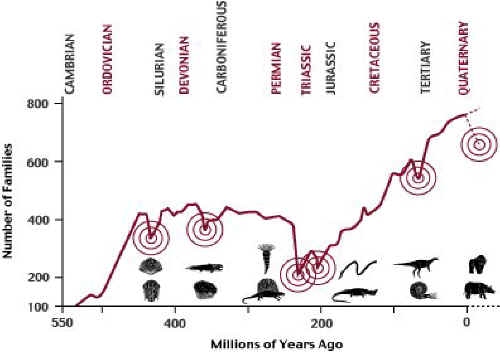 The past: We have already seen geologic records of the effects of ocean acidification:
The past: We have already seen geologic records of the effects of ocean acidification:
- The PETM.
- The Cretaceous-Paleogene boundary, which exhibited a significant extinction event in carbonate-secreting organisms.
- Looking farther back, taxonomic patterns of extinction at the end of the Permian suggest that mortality was especially high among creatures that didn't actively regulate CO2.
How does climate change effect life on land? It is tempting to think that as Earth warms and climate zones shift, critters can just follow the climate zones to which they are adapted. Indeed, according to a current report by Xu et al., plant species in the North American arctic have shifted their ranges northward between 240 and 430 miles since 1980, and are blooming earlier.
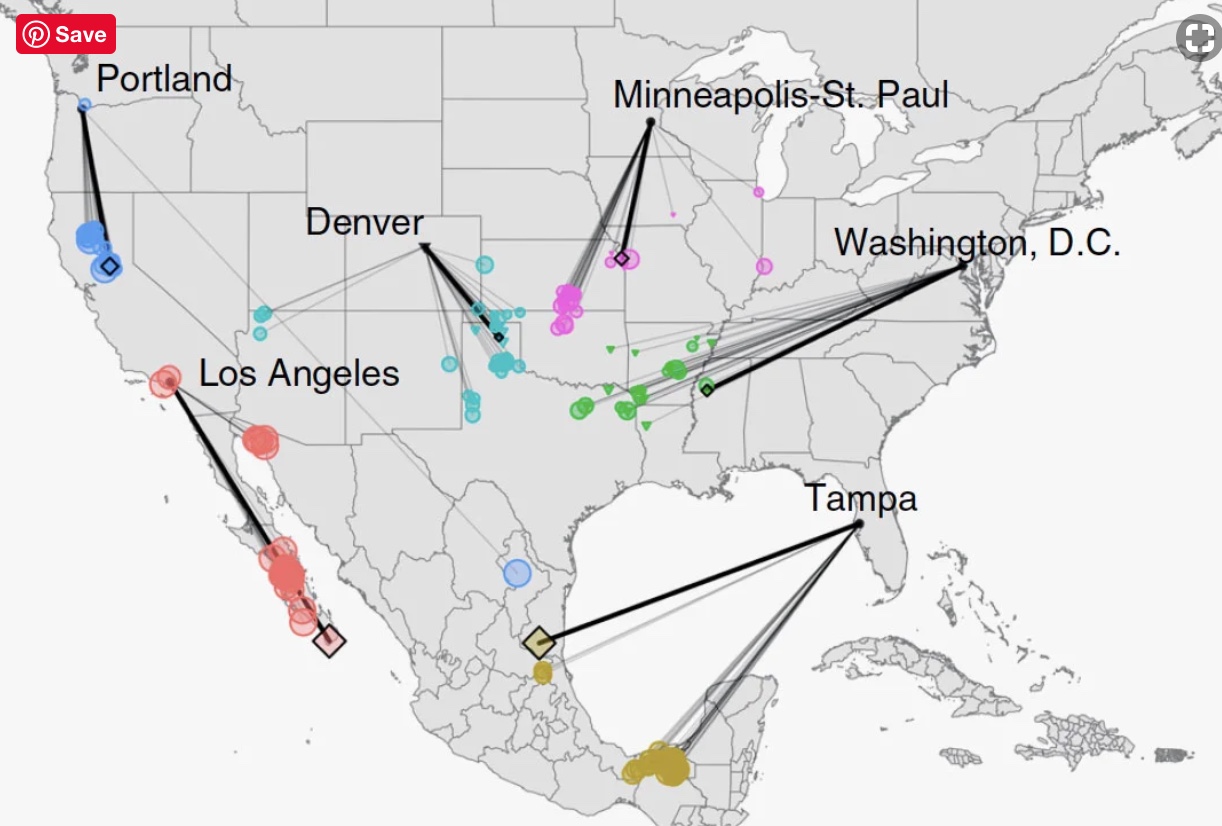
Your climate in 2080
- Recent analyses projecting the climates of major cities in 60 years show that climate does not simply shift north and south but is affected by geography. (Right)
- Xu et al. 2017 point out that the range shift trend is less exaggerated in lower latitudes, such that migrating birds and insects that react to normal mid-latitude cues may arrive late for their high latitude rendezvous with blooms of food resources.
Lessons from the past:
Topography of western Eurasia- Discordant Pleistocene faunas: Analysis of faunas preserved in cave deposits shows that at the last glacial maximum, faunas not merely consisted of more cold-adapted animals, but were made up of creatures that, today may live thousands of miles apart.
- Migration barriers: Compare maps of Eurasia and the New World and you will note that Eurasian mountains tend to run east to west. What if you were a French mammoth at the beginning of the last glacial and wanted to follow your favored climate zone south? You would encounter the growing ice-sheet of the Pyrenees and not be able to cross.
 No place to go: Organisms adapted to high latitudes/altitudes have no place to go. Those most directly effected are creatures of the arctic like polar bears, but creatures at home near the snow line of mountain slopes like the pika (right) are running out of space also.
No place to go: Organisms adapted to high latitudes/altitudes have no place to go. Those most directly effected are creatures of the arctic like polar bears, but creatures at home near the snow line of mountain slopes like the pika (right) are running out of space also.
Artificial barriers and habitat fragmentation: Organisms requiring large home ranges like the puma, lacking the ability to move long distances to new habitats like the blind cave salamander of Barton Springs, or unable to cope with human conversion of landscapes to agriculture or urbanization are unable to navigate the patchwork of natural environments left by human encroachments.A recent analysis by Thomas et al. 2004 models the probability of species extinction based on expected changes in species ranges by 2050 and determine that depending on whether you assume minimum or maximum climate change, between 18% and 35% of species will be "committed to extinction" by 2050.
"Temperature" does not equal "Climate": But all of that takes a simplistic view in which we talk about shifting climate zones but really mean shifting temperature zones. Climate involves the interplay of many factors. E.G. Changes in the location and timing of rainfall will complicate the climate zone picture in many cases. Current observations are consistent with predictions:- High latitudes are becoming wetter, tropics drier.
- More intense rainfall would increase runoff and reduce infiltration into the soil.
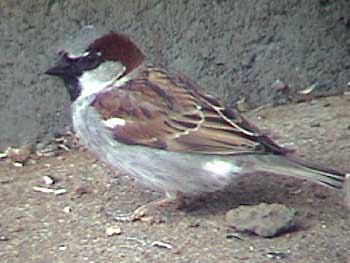 But this doesn't even consider the time scale. Evolutionary change
normally occurs on the scale of million of years, ecological change on the
order of millenia. Here we have a major climate change happening on an
order of decades. The only creatures able to cope easily with this are ecological generalists who are already equipped to survive in any of the range of environments that might result. (i.e. weeds and pests like the house sparrow).
But this doesn't even consider the time scale. Evolutionary change
normally occurs on the scale of million of years, ecological change on the
order of millenia. Here we have a major climate change happening on an
order of decades. The only creatures able to cope easily with this are ecological generalists who are already equipped to survive in any of the range of environments that might result. (i.e. weeds and pests like the house sparrow).
- Discordant Pleistocene faunas: Analysis of faunas preserved in cave deposits shows that at the last glacial maximum, faunas not merely consisted of more cold-adapted animals, but were made up of creatures that, today may live thousands of miles apart.

